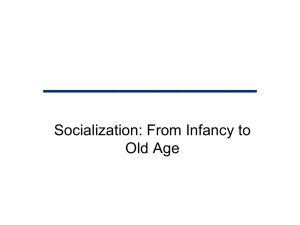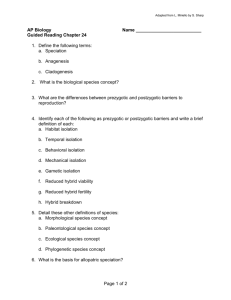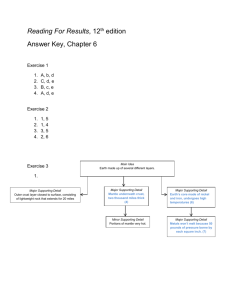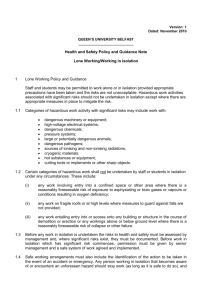Effects of Childood Isolation
advertisement
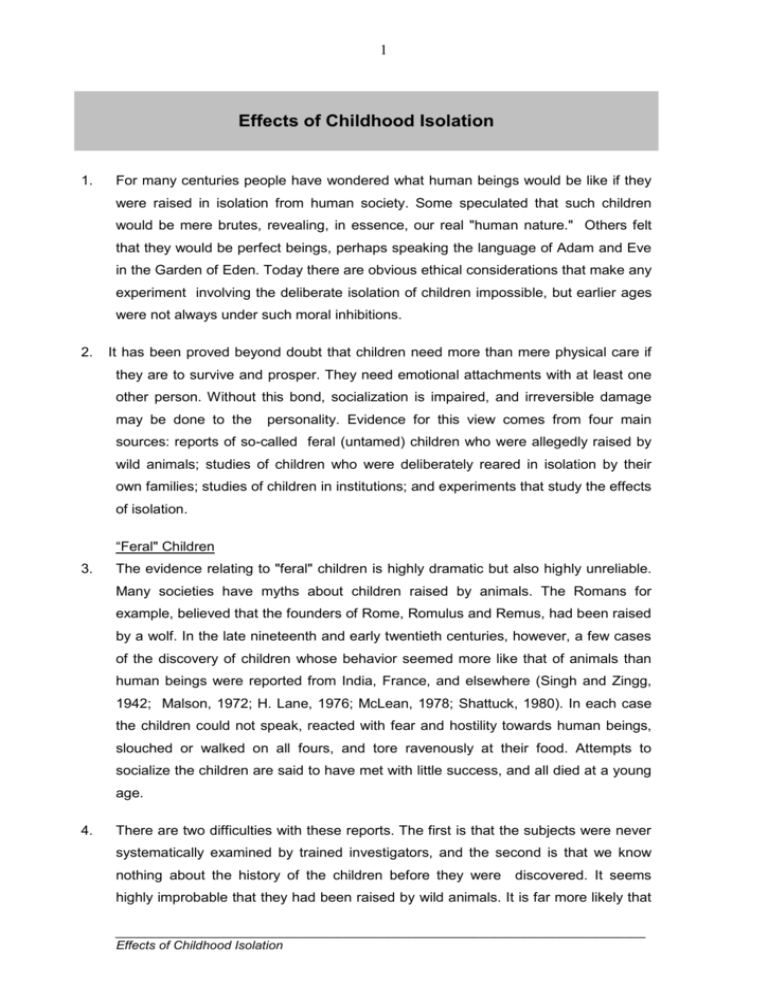
1 Effects of Childhood Isolation 1. For many centuries people have wondered what human beings would be like if they were raised in isolation from human society. Some speculated that such children would be mere brutes, revealing, in essence, our real "human nature." Others felt that they would be perfect beings, perhaps speaking the language of Adam and Eve in the Garden of Eden. Today there are obvious ethical considerations that make any experiment involving the deliberate isolation of children impossible, but earlier ages were not always under such moral inhibitions. 2. It has been proved beyond doubt that children need more than mere physical care if they are to survive and prosper. They need emotional attachments with at least one other person. Without this bond, socialization is impaired, and irreversible damage may be done to the personality. Evidence for this view comes from four main sources: reports of so-called feral (untamed) children who were allegedly raised by wild animals; studies of children who were deliberately reared in isolation by their own families; studies of children in institutions; and experiments that study the effects of isolation. “Feral" Children 3. The evidence relating to "feral" children is highly dramatic but also highly unreliable. Many societies have myths about children raised by animals. The Romans for example, believed that the founders of Rome, Romulus and Remus, had been raised by a wolf. In the late nineteenth and early twentieth centuries, however, a few cases of the discovery of children whose behavior seemed more like that of animals than human beings were reported from India, France, and elsewhere (Singh and Zingg, 1942; Malson, 1972; H. Lane, 1976; McLean, 1978; Shattuck, 1980). In each case the children could not speak, reacted with fear and hostility towards human beings, slouched or walked on all fours, and tore ravenously at their food. Attempts to socialize the children are said to have met with little success, and all died at a young age. 4. There are two difficulties with these reports. The first is that the subjects were never systematically examined by trained investigators, and the second is that we know nothing about the history of the children before they were discovered. It seems highly improbable that they had been raised by wild animals. It is far more likely that __________________________________________________________________________ Effects of Childhood Isolation 2 they had been abandoned by their own parents shortly before they were discovered by other people. It is also possible that the children were already mentally disturbed, autistic, or had been raised in some form of isolation before being abandoned (Bettelheim, 1959). Children Raised in Isolation 5. Much more convincing evidence comes from studies of children who were deliberately raised in isolation by their own families. Two such instances, both occurring in the United States, have been reported by Kingsley Davis (1940, 1947). 6. The first child, Anna, was discovered at the age of six. She had been born illegitimate, and her grandfather had insisted that she be hidden from the world in an attic room. Anna received a bare minimum of physical care and attention and had virtually no opportunities for social interaction. When she was found she could not talk, walk, keep herself clean, or feed herself, and she was totally apathetic, expressionless, and indifferent to human beings. In fact, those who worked with her believed at first she was deaf and possibly blind as well. David (1948) comments: "Here, then, was a human organism which had missed nearly six years of socialization. Her condition shows how little her purely biological resources, when acting alone, could contribute to making her a complete person.” 7. Attempts to socialize Anna had only limited success. The girl died four-and-a-half years later, but in that time she was able to learn some words and phrases, although she could never speak sentences. She also learned to use building blocks, to string beads, to wash her hands and brush her teeth, to follow directions, and to treat a doll with affection. She learned to walk but could only run clumsily. By the time of her death at almost eleven she had reached the level of socialization of a child of two or three. 8. The second child, Isabelle, was discovered about the same time as Anna and was approximately the same age, six-and-a-half. She too was an illegitimate child, and her grandfather had kept her and her mother, a deaf-mute, in a dark room most of the time. Isabelle had an advantage over Anna, of social interaction with her mother, but she had no chance to develop speech; the two communicated with gestures. When Isabelle was discovered, her behavior toward other people, especially men, was "almost that of a wild animal." At first it was thought that she was deaf, for she did not appear to hear the sounds around her, and her speech was a strange __________________________________________________________________________ Effects of Childhood Isolation 3 croaking sound. The specialists who worked with her pronounced Isabelle feebleminded and did not expect that she could ever be taught to speak. 9. Unlike Anna, however, Isabelle had the advantage of being treated by a skilled team of doctors and psychologists. After a slow start, she suddenly spurted through the stages of learning that are usually characteristic for the first six years of childhood, taking every stage in the usual order but at much greater speed than normal. By the time she was eight-and-a-half years old she had reached an apparently normal level of intellectual development and was able to attend school with other children. Her greater progress seems to be related to the skill of her trainers, and the fact that her mother was present during the isolation, and the fact that, unlike Anna, she was able to gain the use of language. Institutionalized Children 10. The socialization of children who are raised in orphanages and similar institutions differs from that of other children in one very important respect. Institutionalized children rarely have the chance to develop close emotional ties with specific adults, for although the children may interact with a large number of staff members, the attendants simply do not have the time to devote much personal attention to any one individual. The standard of nutrition and other physical care in institutions is sometimes good and comparable to that in private homes, but relationships between child and adult are usually minimal. 11. In 1945, the psychologist Rene Spitz published an influential article on the effects that these conditions have on children's personalities. Spitz compared infants living with their mothers with infants of the same age who had been placed in the care of an orphanage. The infants living with their mothers had plenty of opportunity for close social interaction, but those in the institution received only routine care at mealtimes and when their clothing or bedding was changed. Spitz found that the infants in the orphanage were physically, socially, and emotionally retarded compared with the other infants – a difference, moreover, that increased steadily as the children grew older. 12. Spitz's report was followed by a large number of studies on the effects of institutionalization on infants and children, most of which arrived at similar conclusions (Bowlby, 1969; Rutter, 1974). William Goldfarb (1945), for example, compared forty children who had been placed in foster homes soon after birth with forty children who had spent the first two years of their lives in institutions before __________________________________________________________________________ Effects of Childhood Isolation 4 being transferred to foster homes. He found that the institutionalized children suffered a number of personality defects that persisted even after they had left the institutions. They had lower IQ scores, seemed more aggressive and distractable, showed less initiative, and were emotionally cold. Many other studies had reported similar depressing effects on physical, cognitive, emotional, and social development, and have confirmed that such disabilities suffered in early childhood tend to persist or even grow worse in later years (for example, Provence and Lipton, 1962; Yarrow, 1963; Dennis, 1960; Dennis and Najaran, 1957). Monkeys Raised in Isolation 13. Harry Harlow and his associates at the University of Wisconsin have conducted a series of important experiments on the effects of isolation on rhesus monkeys (Harlow, 1958, 1965; Harlow and Harlow, 1962; Harlow and Zimmerman, 1959). Harlow's work has shown that even in monkeys, social behavior is learned, not inherited. The monkeys raised in isolation in his labs behave in a way that is similar to that of human psychotics. They are fearful of, or hostile to, other monkeys, make no attempt to interact with them, and are generally withdrawn and apathetic. Monkeys reared in isolation do not know how to mate with other monkeys and usually cannot be taught how to do so. If female monkeys who have been isolated since birth are artificially impregnated, they become unloving and abusive mothers, making little or no attempt to take care of their offspring. In one experiment Harlow provided isolated monkey infants with two substitute mothers - one made of wire and containing a feeding bottle and one covered with soft cloth but without a bottle. The infant monkeys preferred the soft, cuddly "mother" to the one that fed them. This wretched substitute for affection seemed more important to them than even food. 14. Like all animal studies, Harlow's experiments must be treated with caution when inferences are made for human behavior. After all, we are not monkeys. His studies show, however, that without socialization, monkeys cannot develop normal social, sexual, emotional, or maternal behavior. Since we know that human beings rely much more heavily on learning than monkeys do, it seems fair to conclude that the same would be true for us. 15. The evidence from these varied sources, then, points overwhelmingly in the same direction: without socialization, we are almost devoid of personality and are utterly unable to face even the simplest challenges of life. Lacking the instincts that guide the behavior of other animals, we can become social and thus fully human only by learning through interaction with other people. __________________________________________________________________________ Effects of Childhood Isolation 5 __________________________________________________________________________ Effects of Childhood Isolation


